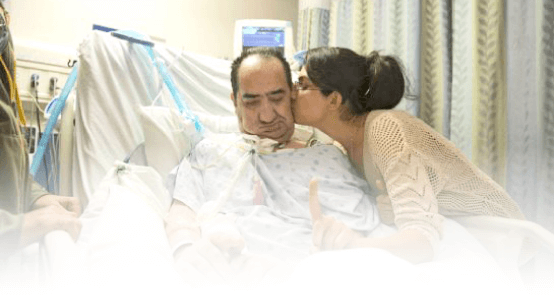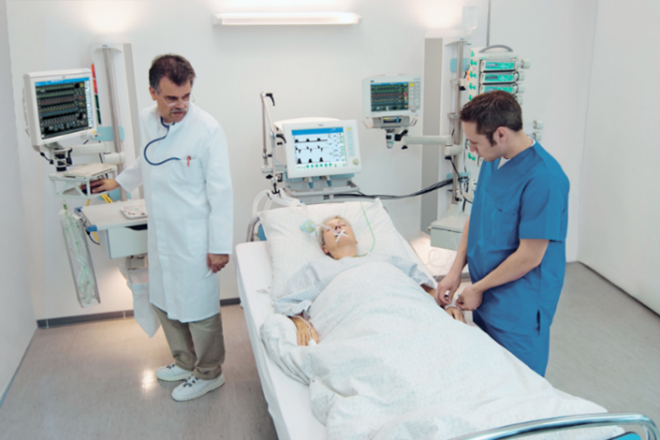Hi, it’s Patrik Hutzel from INTENSIVECAREHOTLINE.COM where we instantly improve the lives for Families of critically ill Patients in Intensive Care, so that you can make informed decisions, have PEACE OF MIND, real power, real control and so that you can influence decision making fast, even if you’re not a doctor or a nurse in Intensive Care!
This is another episode of “YOUR QUESTIONS ANSWERED“ and in last week’s episode I answered another question from our readers and the question was
You can check out last week’s question by clicking on the link here.
In this week’s episode of “YOUR QUESTIONS ANSWERED” I want to answer questions from one of my clients Nestor, as part of my 1:1 consulting and advocacy. Nestor’s wife is for tracheostomy and PEG and he is asking why the doctors insist on pushing his wife out to LTAC after tracheostomy and PEG.
Why Do the Doctors Insist on Pushing My Wife Out to LTAC After Tracheostomy & PEG (Percutaneous Endoscopic Gastrostomy)? Help!
Nestor: Hi Dr. Roberts! Okay, go ahead.
Dr. Roberts: Yeah, so just talking about her condition, as you are aware with the cardiac arrest, there’s been concerned about anoxic brain injury, meaning that she’s not been able to really wake up. When people have that kind of injury, it makes it hard for them to breathe well on their own for an extended period of time because we have to have some awareness to cough up secretions. And so that’s why that idea of the trach and keeping her more long-term on a vent has been brought up.
Nestor: So, I understand that.
Dr. Roberts: Okay. Going along with the trach, a person needs some form of nutrition and so usually short term we can do that feeding tube through the nose, but it’s not very secure and it doesn’t do well long term. And so that’s why we talk about instead transitioning to a PEG tube, which is the procedure where they put a hole in the stomach and put the tube through the stomach so the feeds go in directly. It’s more secure, there’s a risk of sinus infections and sinus problems with the tube in the nose too long. And so the options, if you were to proceed with the trach and the PEG, is much better.
RECOMMENDED:
Nestor: Or just the trach.
Dr. Roberts: So if she did not get the PEG tube, what were you thinking in terms of nutrition? How would she get that?
Nestor: Just the feeding tube through the nostrils and like I said, it would be temporary and then maybe later on looking at doing a PEG.
Dr. Roberts: Okay.
Nestor: But just not at the same time.
Dr. Roberts: Okay. So I’m sorry, what was the question again, regarding?
Nestor: What are the other options as far as, versus sending her LTAC, long term acute care? Is that the only option as far as care?
Dr. Roberts: No. So I guess the other options possibly would be to send her into a nursing facility that takes patients on ventilators. And then this third option would be to try to go back home with this kind of care. Do you have any question?
Nestor: Is that sort of in-home intensive care or?
Dr. Roberts: So, the family would usually be responsible for all this general nursing care, generally speaking. Usually, insurance doesn’t cover for a home nurse to be at the house continuously.
Nestor: So, when they have home healthcare, and they have nurses to come out and see her?
Dr. Roberts: And usually it’s just intermittent where they would come to check on her.
Nestor: Okay.
Dr. Roberts: But not very extensive throughout the day. And so, it’s very rare that a family would be able to handle all of this care at home. But I won’t say it’s absolutely impossible. And if that’s something that you really want to explore, then we would talk to our social worker about all the details.
Nestor: The healthcare facility nearby, what type of center is that?
Dr. Roberts: Not that familiar. I think it’s a sort of a neuro rehab center. I’m not quite sure if they would take patients in her condition on a ventilator.
Nestor: Because I’ve seen, just going on YouTube, just seeing different situations where people were taken from one hospital and taken to brain trauma centers, and they take them like that, and they do the care that they need and once they start waking up. Because sometimes it’s just a matter of time. I mean because we’re just day 10 maybe. I’ve seen people that’s been here at this hospital. One gentleman told me that his wife has been here like 38 days. And so I’m like, maybe not the same situation but it’s cardiac and it’s like you got 38 days and we are talking 10 days. And it was like, well it’s that you guys don’t think that she’s not going to wake up from this. And you’re just like, well it’s better to just go ahead and get her to where a long-term facility can do what they’re going to do with them. It’s time to just pass her on to another center or whatever.
Suggested Links:
Dr. Roberts: Well I think that generally speaking, if they feel that she’s gotten to us as good as she will get in at this type of setting, then generally we do have patients enter into whatever rehab type setting that they’re going to follow up at the next level of care if she’s stable to do all that.
Nestor: And so she wouldn’t be a candidate because we’re in critical care. What is it? Cardiology critical care. So there’s no other floor, no other place in the hospital that someone in this condition could be cared for.
Dr. Roberts: Well, I’m just trying to understand more. What kind of care are you thinking would be best or what were you thinking?
Nestor: What kind of care would be done if she went to LTAC?
Dr. Roberts: Do you know much about LTAC centers? Have you been to one or have experience?
Nestor: Yeah, I’ve seen how they operate. I’ve done a lot of things. Home care is one of them. And basically the care that she gets, right now she’s not even on a kidney machine. So her kidneys are pretty much working good by themselves. The heart is still beating, the blood pressure is up there. But the different things that you guys come in and check them, LTAC they don’t have the resources. Because they just don’t operate the way you operate. Do you know how LTAC Centre operates?
Dr. Roberts: Well it’s a very high level of care. So it’s not like a nursing home or a general rehab center. And so there are doctors there throughout the day.
Nestor: Have you been in one? Have you been to one to see operate?
Dr. Roberts: I have not.
Nestor: Because that’s one of the things I would recommend that, because they may turn them, they may do just the basic stuff because they don’t have the resources or the staff that’s going to do the things that, like you said, to stimulate the patient. Because the doctor was saying, well she was saying that she’s got the feeder in her nose and she doesn’t, which lets me know she hasn’t seen her. But she moved. The feeding tube is down the throat. So she moved yesterday, maybe you could explain this to me. The nurse was suctioning her and, well first she had the hiccups and she coughed, she would cough, she opens her eyes, and she doesn’t focus on you. But she followed the noise, and her eyes go that way. And yesterday when she was suctioning her, she moved her legs. When my son came to see, she moved her legs. So it’s like you’re saying, oh there’s no movement but there is.
Dr. Roberts: Yeah. I’m not sure who said there’s no movement. I haven’t said that.
Nestor: No, you didn’t. Yeah, but I just talked to Dr. Cris cause I know she said that because I said could we wean them off of the ventilator? But she said in her state, she’s probably not going to be strong enough to breathe by herself. And that was something I was asking could she do it before the trach? But yeah, I understand the trach because I want her to be able to keep breathing. But I know when she’s not, because now she’s sedated a little bit, but she says not enough sedation to where she couldn’t respond. And I know she’s full of sedatives, she’s been filled with sedatives and paralytics.
I know that. And sometimes it does take a while for it to wear off because opiates are addictive. One of the withdrawals when you’re going through withdrawal after being on opiates, your body is slow at waking up. So I wanted her to have enough time to actually fully wake up without being on any sedatives. Because she reacts to, I think it might have been an insulin shot, but she got a shot, and she started breathing faster than the ventilator. That’s why she had to have the sedative. So to me, if she reacts to stuff like that, that her starting part of the brain knows what’s happening. Her pupils are still reacted to light.
Dr. Roberts: Sure. So I guess I feel like what you’re asking or saying is that she’s not brain dead, which is where she would be, have no pupil response, no movement. We know she has brain injury. The full extent of what it’s going to look like for her in the future. We can’t say with a hundred percent certainty.
Nestor: Right, it takes time.
Dr. Roberts: We do know that there is damage and so we expect that there will be always cognitive changes. But I understand what you’re saying, that she’s had sedatives, you want to make sure that there’s nothing impairing her like the sedatives still in her body
Nestor: Or explain the movement.
Dr. Roberts: And so we can move, we can have reflexes, she can have some and maybe she could even have some level of awareness. But I think what we’re concerned about is will she gain enough cognitive function where she’ll have a quality of life, be able to talk to her loved ones and interact and have those meaningful communication level.
Recommended:
- Quick tip for families in ICU:Should your loved one go from ICU to LTAC with multiple comorbodities?
Nestor: And that comes with time. I’m saying 6 to 12 months. It can take that long if that’s going to happen. So that’s why I’m saying my biggest concern is putting her in a facility that is basically, they’re going to come in, they’re going to clean the trach, they’re going to rotate her. It’s not a nursing home, but they operate like one. When you look at, I mean because you’re in palliative care, but you’re not going to see how LTAC operates. But you’re still saying, hey send to LTAC. Because that’s where they’ll do this, they’ll do that. They don’t have the resources.
Dr. Roberts: Yeah. I think it goes back to what you were asking, what are the options? And unfortunately, the options are what they are. The LTAC, looks just like a regular nursing facility for ventilator patients. In terms of the LTAC, the idea would be just short term to try to get her weaned from a ventilator if possible. So that would be one of the purposes of it.
Nestor: So what you’re saying is it’s either she goes to LTAC or she goes to a nursing home or she goes to home.
Dr. Roberts: I’ll have to really double check with our social worker. But I’m pretty sure those are the main three options.
Nestor: Will I ever get to speak to the social worker? Yeah,
Dr. Roberts: Sure.
Nestor: Okay. So with the social worker, is she going to come with the same because when you all come in, literally everybody has said the same thing. So is she’s going to come with that or she’s going to come with just different options or she basically, know the same. She’s going to do same thing you’re doing.
Dr. Roberts: I’m pretty sure that this is the correct information, but I don’t want to say I know everything. So I’ll definitely have a social worker talk to you just to confirm this.
Nestor: Not that I’m not even concerned about whether it’s correct or not. I’m concerned about if she would know of any other facility or because as far in the military, our social workers, they would work hand in hand with different facilities that took different type of patients. Like the nearby center, you’re not familiar with that, but she might be familiar with it at what level? So that’s what I’m not looking for who’s correct because I’m past that. I just want to know the best options for her in her condition right now.
Dr. Roberts: I hear you.
Nestor: You can ask her first.
Dr. Roberts: I will talk to her and ask her if she is familiar more with the center and things of that nature.
Nestor: Okay. So it’s you and Dr. what was it… What’s her name? Amy?
Dr. Roberts: Dr. Ariane.
Nestor: You all are with, how do you say it? Palliative care? And you’re Dr. Roberts? And okay. Dr. Ariane, I met her on, it might have been Sunday or Saturday.
Dr. Roberts: Yes.
Nestor: Okay. So yeah, guess we’ll just go from there because Dr. Sandy said that the sedatives that she’s on is pretty light. And this is just her sleeping. It’s my wife. We’ve been together since we was like 20. So I want her to get the best care that she possibly can so that she can get back to just being more than what she is right now.
Dr. Roberts: How are you holding up?
Nestor: You see me, I had to put on a different coat because right now I am her advocate, so I’ve got to make sure that I’m doing everything that I’m supposed to do to make sure that the care’s good. Like I told the critical care doctor, the nurses and the different teams that are coming to her and seeing her, they’re watching her, they’re doing it. I mean they’re doing it. They’re really giving her some good care. To go from good care to go to mediocre, I’ve seen it. I’ve seen it.
Dr. Roberts: Okay. Well there’s more than one LTAC.
Nestor: Google the results and see what they have. I have to look up the results and see what they’re like. But I just wanted to know what the options are.
RECOMMENDED:
Dr. Roberts: I see.
Nestor: So yeah.
Dr. Roberts: Yeah. I’m sorry I don’t have different answers for you.
Nestor: No, that’s fine.
Dr. Roberts: But it sounds like I will not be able to reach the social worker tonight since it’s past five.
Nestor: Oh, okay.
Dr. Roberts: But I’ll talk to her tomorrow morning and ask her to give you a call.
Nestor: You have one assigned to this floor?
Dr. Roberts: Yes.
Nestor: Oh, okay. Great. What’s her name?
Dr. Roberts: Off the top of my head I don’t remember because it just changed recently.
Nestor: Oh, okay.
Dr. Roberts: But I will find out all of that for you and ask her to give you a call if you’re not here.
Nestor: Okay, that’s Fine.
Dr. Roberts: Okay. Thank you.
Nestor: You’re welcome.
Dr. Roberts: Thanks for talking with me. I’ll see ya.
Nestor: All right. Bye.
The 1:1 consulting session will continue in next week’s episode.
How can you become the best advocate for your critically ill loved one, make informed decisions, get peace of mind, control, power and influence quickly, whilst your loved one is critically ill in Intensive Care?
You get to that all important feeling of making informed decisions, get PEACE OF MIND, CONTROL, POWER AND INFLUENCE when you download your FREE “INSTANT IMPACT” report NOW by entering your email below!
In Your FREE “INSTANT IMPACT” report you’ll learn quickly how to make informed decisions, get PEACE OF MIND, real power and real control and how you can influence decision making fast, whilst your loved one is critically ill in Intensive Care! Your FREE “INSTANT IMPACT” Report gives you in-depth insight that you must know whilst your loved one is critically ill or is even dying in Intensive Care!
Sign up and download your FREE “INSTANT IMPACT” REPORT now by entering your email below! In your FREE “INSTANT IMPACT” REPORT you’ll learn how to speak the “secret” Intensive Care language so that the doctors and the nurses know straight away that you are an insider and that you know and understand what’s really happening in Intensive Care! In your FREE report you’ll also discover
- How to ask the doctors and the nurses the right questions
- Discover the many competing interests in Intensive Care and how your critically ill loved one’s treatment may depend on those competing interests
- How to Eliminate fear, frustration, stress, struggle and vulnerability even if your loved one is dying
- 5 mind blowing tips & strategies helping you to get on the right path to making informed decisions, get PEACE OF MIND, control, power and influence in your situation
- You’ll get real world examples that you can easily adapt to you and your critically ill loved one’s situation
- How to stop being intimidated by the Intensive Care team and how you will be seen as equals
- You’ll get crucial ‘behind the scenes’ insight so that you know and understand what is really happening in Intensive Care
- How you need to manage doctors and nurses in Intensive Care (it’s not what you think)
Thank you for tuning into this week’s YOUR QUESTIONS ANSWERED episode and I’ll see you again in another update next week!
Make sure you also check out our “blog” section for more tips and strategies or send me an email to [email protected] with your questions!
Also, have a look at our membership site INTENSIVECARESUPPORT.ORG for families of critically ill Patients in Intensive Care here.
Or you can call us! Find phone numbers on our contact tab.
If you want a medical record review, please click on the link here.
Also check out our Ebook section where you get more Ebooks, Videos and Audio recordings and where you can also get 1:1 counselling/consulting with me via Skype, over the phone or via email by clicking on the products tab!
This is Patrik Hutzel from INTENSIVECAREHOTLINE.COM and I’ll see you again next week with another update!









